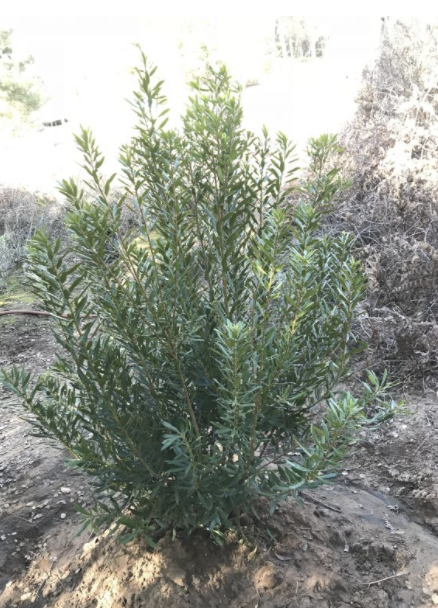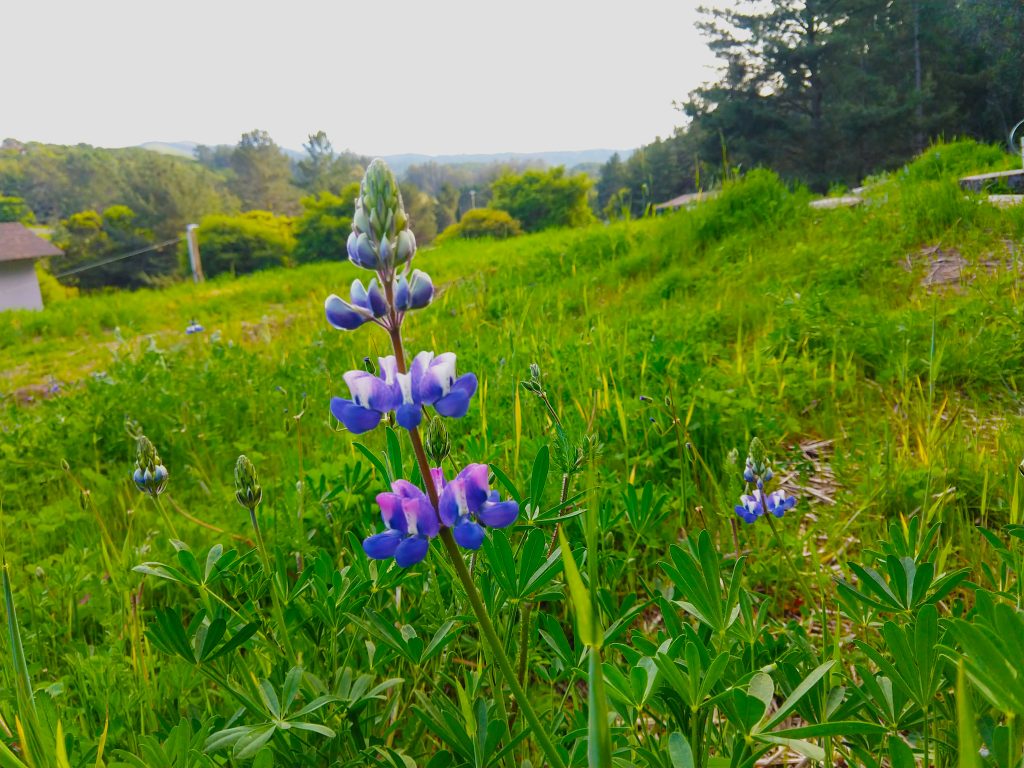
While our checklog beds are all cozy for the winter with their cover crop, compost, and mulch keeping them warm, wet, and nourished, we’ve been focussing on some other planting. Even though it’s winter, we’re giving our pollinator garden, silvopasture, and food forest some special tending. To clear a space for the food forest, we’ve been gradually taking down the invasive Eucalyptus trees that grow like weeds around here. Now we can start to plant native species. One of my new favorites is Myrica Californica, otherwise knows as the Pacific Wax Myrtle.
We were looking for some fast- growing native pioneer trees to establish the canopy layer of our food forest, and the local nursery recommended the Pacific Wax Myrtle. It can grow 2-4 feet a year, reaching a height of 10 to 30 feet, and is hardy, tolerating drought, flood, and our sandy soil. It’s a pretty evergreen, with berries in the fall that attract birds. I’ve read that tinctures or powders made from the root or bark have medicinal uses to sooth inflammation and combat cold and sinus issues. My favorite thing about this merry myrtle is that it has nodules on its roots that contain nitrogen-fixing microorganisms. These allow the myrtle to not only survive in poor soil, but to improve the soil.

Improving soil health is a major focus of ours, since soil is the foundation of the flourishing ecosystem we seek to cultivate here. Our cover crop mix this year is full of nitrogen fixers too, including a nitrocoated seed mix of Blando Bromegrass, Annual Ryegrass, Crimson Clover, Rose Clover, and Nitro Persian Clover. Common nitrogen fixers are in the Fabaceae family and include legumes, clover, peanuts, lupins, and alfalfa. Our soil tends to be sandy and low in organic matter, and so we get excited to see the lupin and clover come up in the rainy season. So thank you to the nitrogen fixing plants, and the microorganisms on the root nodules, and your complex chemistry that is improving our soil health, and thereby improving our health.
I love this concept we find in nature where a symbiotic relationship between plant and microorganisms creates a more nutrient-rich environment for each, while improving overall soil health. Here we find a version of competition that is also cooperative, because what gives the plant a competitive advantage to survive is also what allows its local ecosystem to thrive. Perhaps it is a false dichotomy, in the human world, that we can be either competitive or cooperative. We at Terra Cultura are excited to explore models where what benefits us (economically, socially, environmentally) is also what benefits our plant, animal, and human communities. We look forward to creating thriving plant, animal, and human ecosystems with you in the new year.


Hi Rachel!! I loved reading this. I am very impressed!!! Looking forward to future postings. Thank you!!
Thanks for reading Jesse! Perhaps you would be interested in a guest blog post on the power of music someday, since you’re the local troubador of Aromas! : )
I love the notion of cooperating and competing at the same time. You know, I worked in the human service world for decades, and saw much of this. Agencies and organizations, while competing for the same clients, can still find ways of working together to achieve a common good–fill service gaps, seek funding for a new type of service, or seek additional funding to serve a new client group. Business is another thing, and in our culture we tend to see business as a kind of warfare. Yet even in business, companies sometimes work together to develop a new product, or expand to a new area, or improve things that are already out there. We Americans take our competition so seriously–often to our detriment. I am reminded of a story I read about a Native American tribe. Every young person was eager to find a beehive and bring it back to their village. Of course, getting the beehive would mean getting stung, so it took great bravery and fortitude. However, once the beehive was obtained, not only would the young person be praised and appreciated by everyone, the honey would be shared with the entire village. This is hardly what modern American young people are taught about sharing wealth, eh? I see TerraCultura as being like the young Native American person in the story. Taking on a difficult task, facing trials and challenges, with the goal of making things better for everyone.